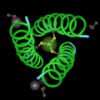 We went on an excursion last weekend to see the Dead Sea Scrolls at the Pacific Science Center. None of us could resist going downtown to look at written texts over 2000 years old. Uncovered in 1946, by a Bedouin shepherd, the scrolls have had an interesting history over the past 50 years, most of it out of the public eye. Only recently, have a large number of scholars and members of the public been granted access.
We went on an excursion last weekend to see the Dead Sea Scrolls at the Pacific Science Center. None of us could resist going downtown to look at written texts over 2000 years old. Uncovered in 1946, by a Bedouin shepherd, the scrolls have had an interesting history over the past 50 years, most of it out of the public eye. Only recently, have a large number of scholars and members of the public been granted access.
We're still kind of amazed that they came to Seattle.
I'm fascinated by archeology, but I was also interested in how DNA analysis is being used to study the scrolls and their possible owners.
Which fragments belong together?
Although a limited number of scholars began looking at the scrolls over 30 years ago, there is much work to be done in deciphering the information they contain. There are over 900 scrolls and much of the words lie on 50,000 fragments, separated by and torn apart by ravages of weather and time.
Imagine what would happen if several jigsaw puzzles were taken apart and tossed together in a box. It would be much easier to put the puzzles together if you could at least, sort out which pieces belonged to which puzzle.
This is where DNA analysis is helping out. The same techniques used to identify different humans are being used to identify individual goats. Since all but one of the scrolls are made of goat skin, and it is unlikely that a single goat would supply more than one scroll's worth of skin, researchers can analyze the DNA from each scroll fragment and determine which fragments belong to same scroll.
Who lived in Qumran?
Another interesting application of DNA technology also emerged during in the exhibit.
This bit concerned the ancient settlement of Qumran, located near the caves where the scrolls were found. Qumran is something of a mystery, itself, but archeologists think it was the home of a religious sect, called the "Essenes" and that they were the likely owners of the scrolls.
The Pacific Science center showcases some artifacts that were found at Qumran including sandals, pottery, a comb and several ancient coins. One of the combs looked suspiciously like the flea comb that I used use on our cats. It turns out that the comb had a similar purpose in ancient times and that some of these combs even contained ancient lice, trapped long ago in the tines of the comb.
Here's where DNA comes in. These long dead lice probably bit their human hosts and may have sucked up a bit of human blood. Naturally, researchers are trying to get a bit of this ancient blood, amplify any ancient DNA, and find out more about the people who lived in Qumran.
What more will we learn, looking back across the sands of time? I look forward to finding out.
technorati tags: biology, archeology, DNA sequencing, Dead Sea Scrolls
